News and Articles › Paintings and drawings
The essence of kitsch is the confusion of ethical and esthetic categories; kitsch wants to produce not the “good” but the “beautiful.”
— Hermann Broch, author
Top list
View the entire list
In the fall of 1962, the students at the National Academy of Fine Art in Oslo went on a study trip to Stockholm. Months earlier, Nerdrum had swiftly put together his final, but somewhat sloppily painted picture for the submission to join the academy, and to his own surprise he was accepted.
The negative attitude towards the craft of painting at the school, however, made him doubtful and during the visit to Stockholm, he left his peers at the Museum of Modern Art to look at the collection of classical paintings at the National Museum and the The Conspiracy of Claudius Civilis by Rembrandt van Rijn.
It was like looking into a dark world. That was Claudius Civilis. Pop-art was in fashion at the time. But after my encounter with Rembrandt, I realized that I was left with no other choice. It was impossible to obey the times when this was so overwhelming. I thought that I would never be able to make something that great, but I would rather fail than avoid the risk. This was the way! — Odd Nerdrum, interviewed by Jan-Erik Ebbestad Hansen in 1996

“The Conspiracy of Claudius Civilis” (c. 1661-62) by Rembrandt van Rijn
Rembrandt’s Last Public Commission
In 1660, Rembrandt was no longer a reputable painter, but he received one final public commission to paint one of the hall pictures for the new city hall in Amsterdam. Initially, the decor was intended for his former student, Govert Flinck, who had adapted himself to the latest fashions from France. When Flinck died in the process, Rembrandt was asked to paint “The Conspiracy of Claudius Civilis,” and completed the painting after two years. But the result was so different from the rest of the paintings that the painting was sent back to Rembrandt for reworking, and was therefore never returned to the city’s public space.
The painting ended up in Sweden in the 18th century as the fragmented version that one can see today. Originally, the composition measured almost six meters vertically, and was based on “The Last Supper” by Leonardo da Vinci. The intended viewing distance makes it one of the most loose paintings Rembrandt ever made. The composition is not built up of drawing, but of areas that clash against each other, and a painterly variety between thick and thin brush strokes.
SPOILER ALERT! This is the fourth in a series of six articles based on “The Hunt of Odd Nerdrum” (2018) which is available for streaming at vimeo.com/ondemand/oddnerdrum. I advise everyone to watch the documentary before reading this article.
Members of WWK get 25% off any purchase. Send an e-mail to nerdrum.bork@gmail.com for more information.
Members of WWK get 25% off any purchase. Send an e-mail to nerdrum.bork@gmail.com for more information.
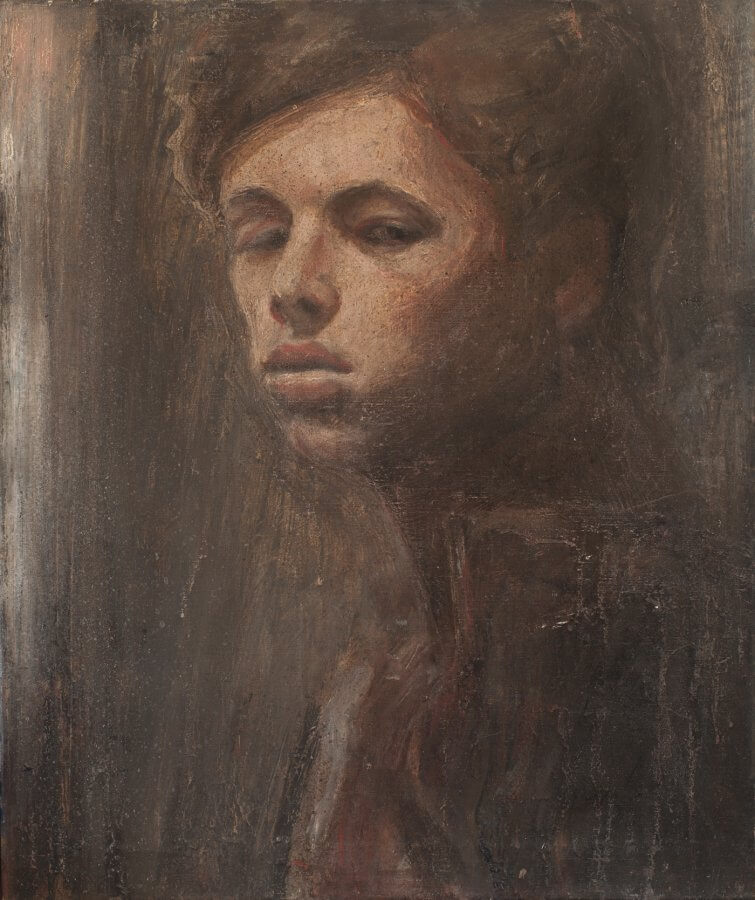
Self Portrait at Age 18 by Odd Nerdrum
“I am the Ideal Picture”
Seeing Rembrandt’s painting makes a strong impression on the eighteen-year-old Nerdrum, and he leaves the Academy of Fine Art shortly afterwards to follow in the footsteps of the old masters.
The first painting he produces as a result of his encounter with Rembrandt in Stockholm is an obliquely facing self-portrait with blurred eyes on a roughly painted background.
In the ’60s and ’70s, Rembrandt watches over the portrait works like a shadow. Vulnerable faces come out of the dark, and confront the spectator. Often it is the painter himself that is depicted. Together with Rembrandt and Edvard Munch, Nerdrum is one of the most prolific self-portrait painters, and in 1983 he exhibits twenty self-portraits based on ten years of studying his own face, at Gallery Tanum in Oslo.
I have always had myself as a role model. You lose when you compare yourself to the beauty ideals, so I prefer to be a winner in my own life instead of a loser in other people’s lives. — Odd Nerdrum, interviewed by NRK Radio in 1983
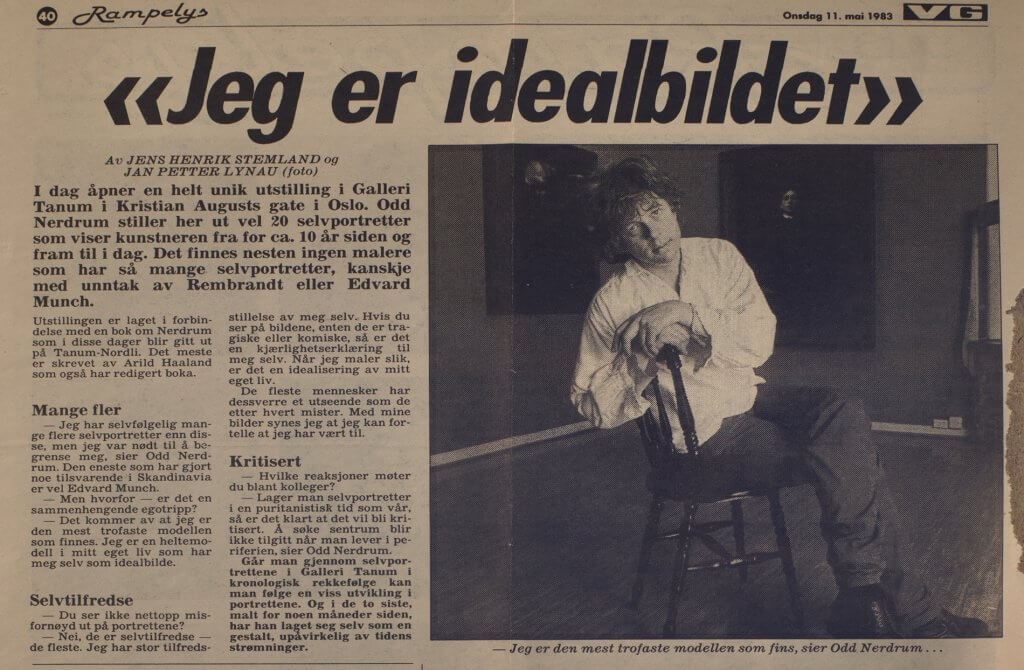
HEADLINE: “I am the Ideal Picture.” Nerdrum’s exhibition of self-portraits in 1983 at Tanum Gallery in Oslo gained a lot of attention.
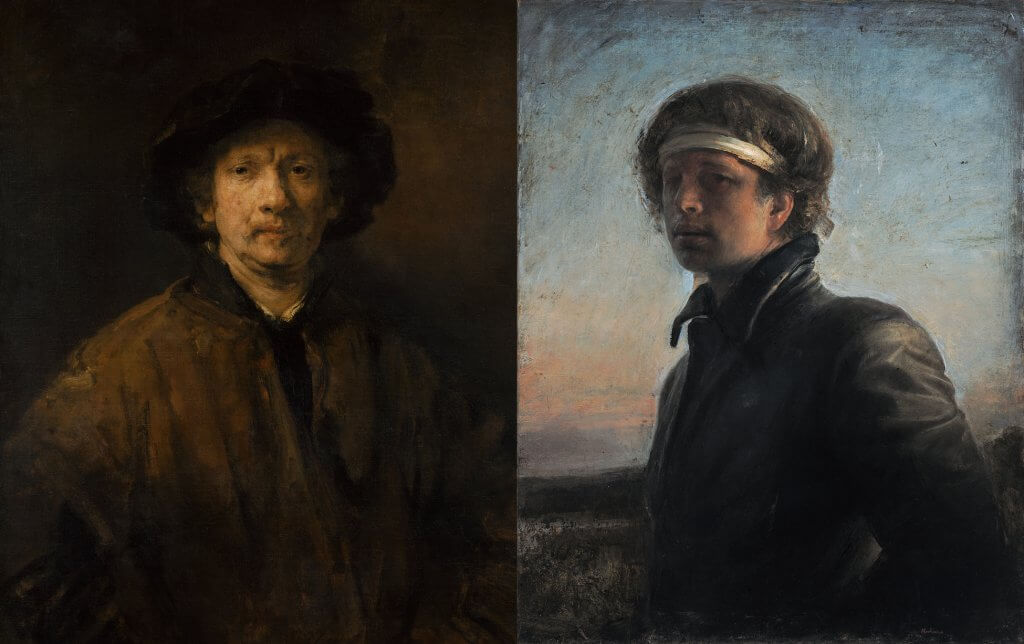
Left: “Self-portrait with Beret” (1652) by Rembrandt. Right: “Self-portrait in Evening Sun” (1979) by Odd Nerdrum.
Breakthrough in America
In 1983, Nerdrum participates in the exhibition, “Norway: In The Romantic Tradition,” at Bellman Gallery in New York. Whilst he is there, he meets the newly established gallerist, Martina Hamilton, who has been informed of his work through her colleague, Robert Feldman. Feldman had just seen Nerdrum’s portrait of Klodvig at the National Gallery in Oslo, and urged Ms. Hamilton to make his acquaintance.
A year later, Nerdrum has his first solo exhibition at Martina Hamilton Gallery on Madison Avenue with works such as Amputation, Refugees at Sea, The Iron Law and Isola. He quickly receives positive reviews from American critics and his paintings are soon bought by institutions such as the Metropolitan Museum, and the Hirshhorn Collection in Washington. The critique he had received in his home country is reduced to a provincial phenomenon, where for the first time their eyes are opened to Nerdrum’s post-apocalyptic paintings.
Picture books are printed, and Nerdrum holds lectures in American academies.
After an absence from all public presence in Norway for six years, he has now been launched in the USA and has reached the top. […] Munch was badly treated, as we know, and so was Arne Ekeland and Kjartan Slettemark, and now one has done it again with Odd Nerdrum. — Jan Åke Pettersson, 1986
When Nerdrum started exhibiting in the big galleries in the USA, the modernists had been dominant for half a century. Relativism, which created the Post-Modern era at the end of the 20th century, allowed the combination of the old and the new, thus liberating culture from the established dogmas. Classical architects, melodic composers such as Arvo Pärt and Philip Glass as well has the painter, Andrew Wyeth, finally received recognition.
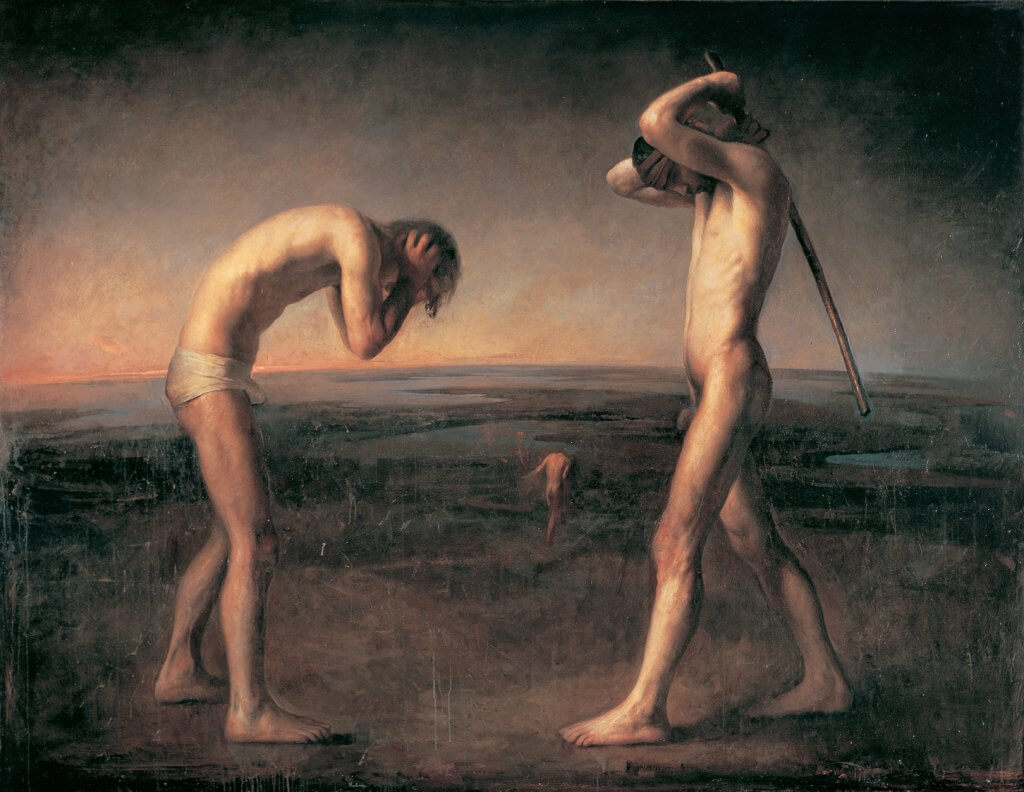
The Iron Law (1984) by Odd Nerdrum
A Change in the Wind
By the late 1990s, “Nerdrum” has become an international name and American students travel across the Atlantic ocean to study with him. The rock musician, David Bowie, created a lot of buzz in Oslo when he bought two paintings and visited Nerdrum’s studio where the mystique was about to surpass the Kristiania Bohemians. The attention nonetheless leads to rising contempt in the art community, and as juror of the Norwegian Culture Council, he discovers that support applications for figurative painters are declined before they ever reach review.
The two-year long “Academy Conflict” denotes a definite turning point for Nerdrum and the post-modern era.
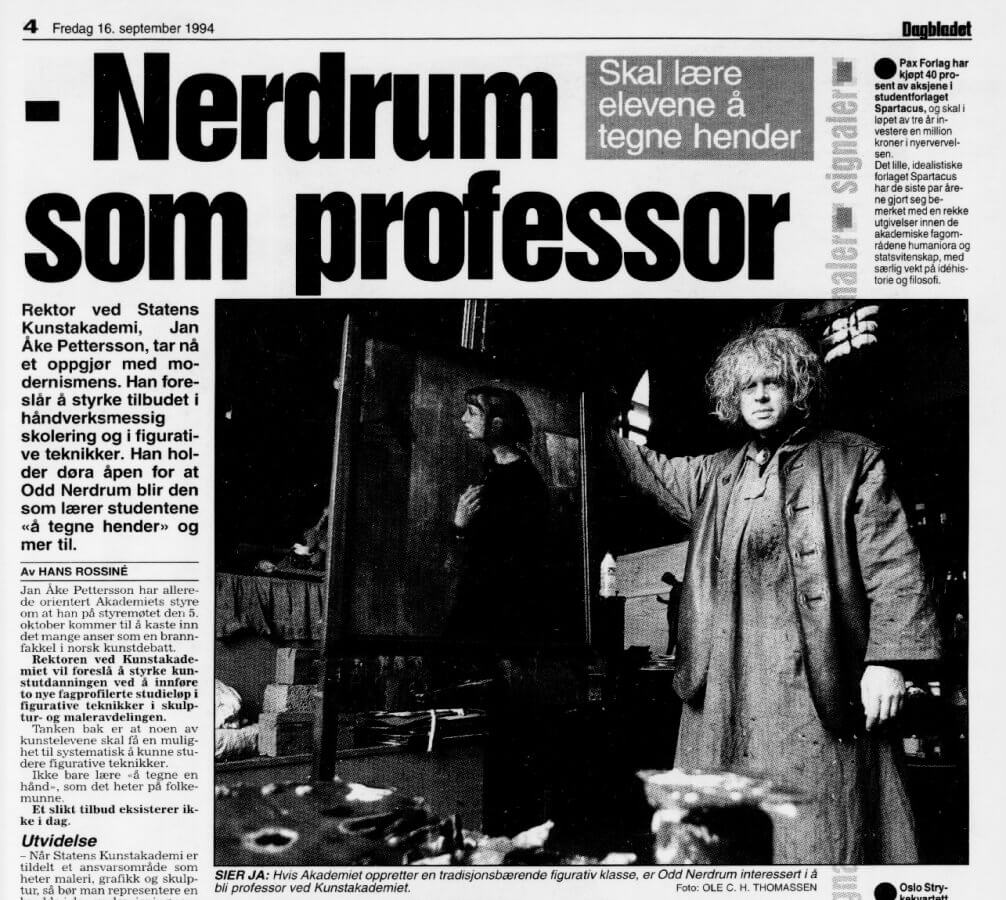
HEADLINE: “Nerdrum for Professorship — shall teach students to draw hands.”
Autumn 1994, the newly appointed principal, Jan Åke Pettersson, announces a proposal for a figurative major at the Art Academy in Oslo. Along with the sculptor, Per Ung, Nerdrum is quickly considered for the professorship, which leads to loud resistance from teachers and students at the academy. On two occasions, the windows of the principal’s office are broken, and posters equating the principal’s view of art with the nazis are posted around the school.
Colleagues like Vebjørn Sand and Thorval Lund Hansen describe Nerdrum’s way of teaching as “culty,” and support the opposition candidate, Jan Sæther, who is also supported by the Academy Board.
After all the fuss, Nerdrum decides to withdraw his candidacy in the spring of 1996.
In an interview with Billedjournalen that stems from this time, he tells the Swedish reporter that modernism is yet again dominating the art world:
Odd N.: There’s nothing wrong with modernism in itself, but it’s modernism’s oppressive and racist methods, which I think are conspicuous, and I thought it would change with Glasnost, when Communism was disbanded in the ’80s, it was about to dissolve due to Postmodernism. But modernism took over again and again, and now we’re back to the same place. With the same form of racism that the modernists perform.
Journalist: You make it sound like it’s a conspiracy.
Odd N.: Yes, it’s a conspiracy against the talent.
Journalist: But it’s not like people organize in order to promote a different kind of art.
Odd N.: No, but Hegel’s spirit of the time can be conspiratorial without people’s awareness, without them paying attention. No one dares to speak their mind because of a totalitarian zeitgeist, everyone’s gagged. Almost no artist dares to utter their sincere meaning in interviews anymore. They’re reiterating the authorities’ ideas, they’re dependent on the money they can receive from the public agencies. I am free to say what I want. But I notice how artists are talking over each other in the same voice, because they’re afraid.
Nerdrum’s Reappropriation of Kitsch
Classical figurative painting does not get a full redemption with Postmodernism, and in the ’90s, Nerdrum notices that the hate against him and his colleagues has returned even stronger.
The sharp rhetoric against the figurative community makes him wonder, and in a collection of essays by the Austrian writer, Hermann Broch, he recognizes the same criticism he has received from the establishment. Descriptions of Kitsch as old-fashioned, imitational, sentimental, and theatrical recurs with most authors that helped shape the term, a swear-word often aimed at romantic painters, composers and architects at the end of the 19th century.
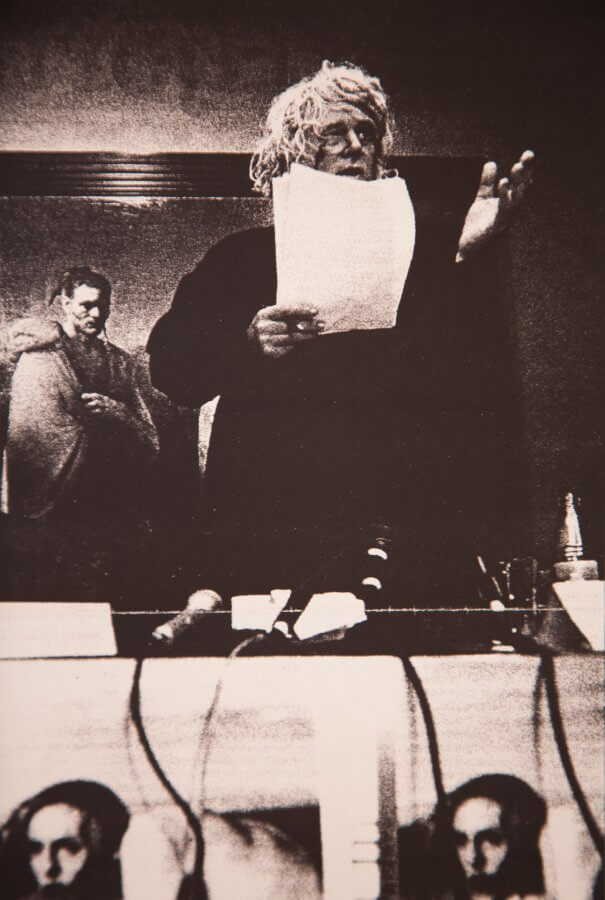
Odd Nerdrum giving his speech about kitsch at The Astrup Fearnley Museum in 1998.
Autumn of 1998, at the opening of his retrospective exhibition at the Astrup Fearnley Museum in Oslo, Nerdrum apologizes for having sailed under a false flag, and declares himself as a kitsch-painter.
The press provides editorial space for the proclamation in all nationwide newspapers. The critics refuse to accept that Nerdrum defines himself outside of art, and dismisses the kitsch declaration as a coquettish desire to remain an outsider.
The launching of the unpopular term is one of the numerous controversies from Nerdrum, who often appears in the spotlight with scandalous paintings, and statements in the press.
How is this going to end? The only thing that comes out of these scandals is a kind of negativity and a lust to take down a human being. — Odd Nerdrum, XLTV 1998
In 2002, a series of articles are published in “Today’s Business.” In several pages, the journalist Lena Lindgren expresses her scepticism in Nerdrum’s finances in a presentation characterized by unproven claims and clear contradictions. Shortly afterwards, Nerdrum receives a letter from the tax authorities, demanding that he account for all sales, including unsold, finished, and works in progress.
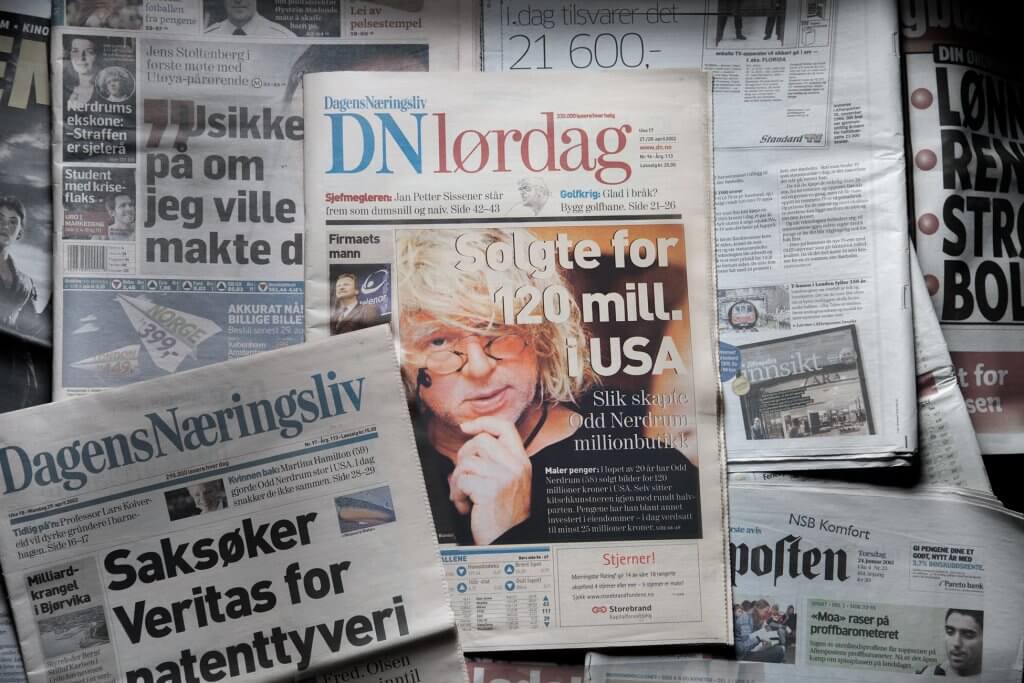
HEADLINE: “Sold for 120 millions (NOK) in the USA.” The newspaper article is filled with undocumented claims about Nerdrum’s economy.
In June 2002, Nerdrum announces that he never again wishes to speak to the Norwegian press, and in the fall of that year, he immigrates with his family to Iceland.
But was it really Lindgren’s sloppy articles on Nerdrum’s economy that triggered the tax authorities to investigate the painter?
The year before, Nerdrum exhibited paintings — that were due for America — at Haugar Museum in Tønsberg. The walls were covered with what seemed to be replicas of Nerdrum’s most iconic works from the 1980s. Finally, the tax authorities showed up at the museum and interrogated the gallerist, Jan Åke Pettersson. They had studied Nerdrum’s picture books and found the entire exhibition to be of a suspicious character.
It turns out, however, that Nerdrum and his students had been quiet about a problem for a long time, although not the kind of problem that the tax authorities expected when they began their investigation into the affair which Nerdrum would later regard as “The Great Disaster.”
The Black Oil
Since Nerdrum was eighteen years old and saw “The Conspiracy of Claudius Civilis” at the National Museum in Stockholm, he has tried to recreate the techniques of the old masters. Lack of traditional workshop training forced him, however, to fumble on his own, and everything from canvas preparation to lightfast pigments, he has needed to test at his own risk. Consequently, the road to the old master’s techniques brought him failures of consequence.
During the period of Social Realism in the 1970s, Nerdrum experimented with different oil mediums to achieve a softer and more Rembrandtesque skin painting. In New York he met James Mason, who had studied with the painter, Jacques Maroger, former technical director at the Louvre, and author of a book about the secrets of the old masters. Mason claimed to have improved his teacher’s method and advised a mixture of black oil, turpentine and mastics, a recipe that Nerdrum embraced after consulting the chief conservator at the Munch Museum.

“Self-portrait in Evening Light” (1984) by Odd Nerdrum.
Years later, in 1988, Nerdrum is invited to the home of a private collector after holding a lecture at the San Francisco Academy. On the collector’s wall he sees his four-year-old “In Evening Light” in an unrecognizable condition. The paint, which has got a honey-like consistency, has begun to sag down the canvas. Many years of California heat has fast-forwarded a reaction in the oil medium, and has left visible irregularities in the transition between sky and skin. To Nerdrum’s despair, the paint continues to sag after several attempts to repair the picture, and complaints keep coming in one after another from several collectors in America.
In shock, Nerdrum stays in bed for many days. At the same time, his students encounter the same fate, iconic works such as “The Cloud,” “Iron Law,” and “The Return of the Sun,” are slowly dissolving.
Nerdrum realizes that the black oil has inflicted his entire ’80s production with irreparable damage, forcing him to take action.
Whilst the gallerist in New York tries to calm down the collectors, Nerdrum decides to paint all the pictures again.
One after another, new versions of the paintings are created in the night in his studio at Uranienborg in Oslo. Monumental works such as “The Ultimate Sight,” and “The Night Guard” are painted with new models and thorough details before they are sent back to their owners.
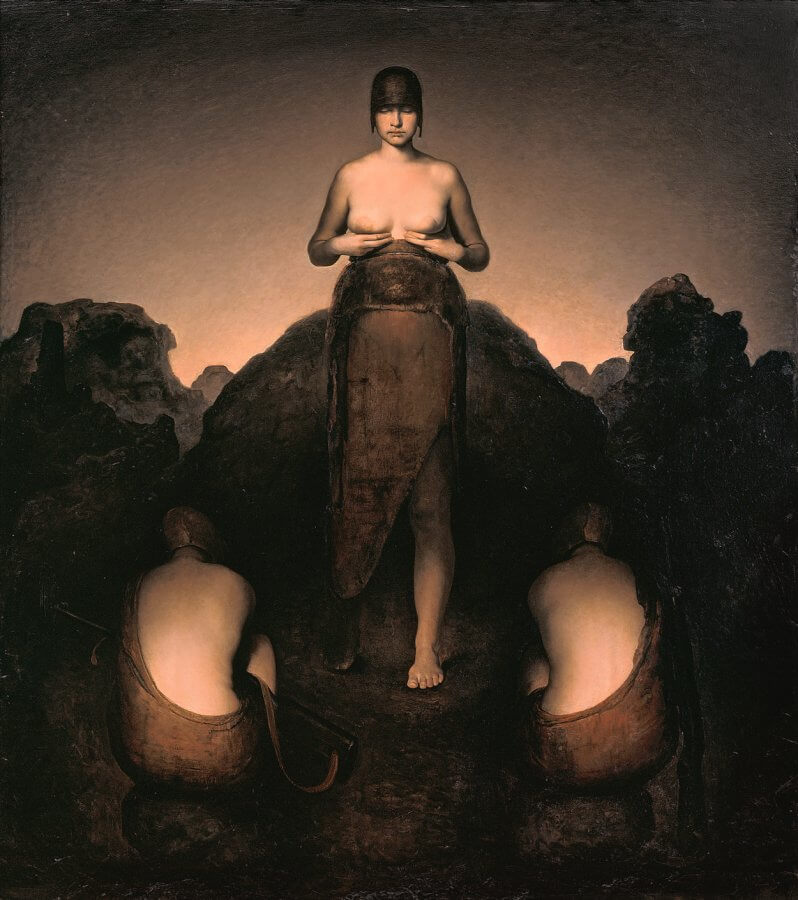
Woman with Milk, 1988 (first version) by Odd Nerdrum
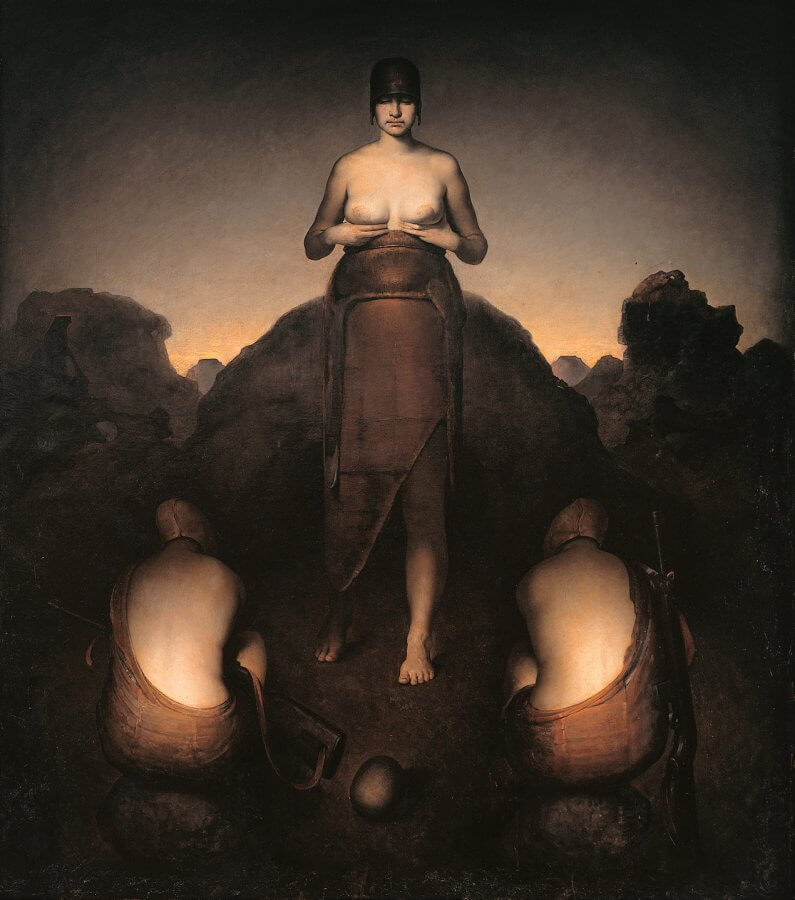
Woman with Milk, 1993 (second version) by Odd Nerdrum
In 1997, ties are cut with his agent, Martina Hamilton, and Nerdrum contacts Forum Gallery on Fifth Avenue in New York where rumours about “rain paintings” have reached the gallery owner, Robert Fishko. Customers have demanded money in compensation, and because of price increases on his paintings, Nerdrum is often forced to pay three times the original market value. Despite that he has converted to a safe oil mixture, Fiskho is worried and they settle on a five-year agreement, and create a safety deposit box for retention of Nerdrum’s revenue as an insurance against future damage claims. In total, $900,000 USD in checks are frozen at the Raiffeisen Bank in Austria, and the majority is first released in 2002, when the danger of claims for re-compensation have become substantially smaller.
All in all, Nerdrum paints more than thirty replicas over a period of fifteen years. Some pictures are never repainted, and to this day they remain history.
The Tax Case
Nine years after the articles in “Today’s Business,” Nerdrum is sentenced to two years of imprisonment by the District Court after having been accused of selling paintings for fourteen million kroners between 1998 and 2002 without disclosing the income to the tax authorities.
The compensation funds for the destroyed paintings is unanimously regarded as unreported income despite the fact that the tax authorities cannot name which paintings they claim have been sold under the table. Instead, the prosecutor proclaims that Nerdrum should disprove the allegations and thus turns the burden of proof upside down in a case where the public sentiment is that Nerdrum must not be held to a different standard from everyone else.
In the aftermath of the trial, Nerdrum breaks his silence for the first time since 2002 at a talkshow in Sweden:
In 1996, the leader of the Department of Economic Crime was at a party, where he was undercover before he suddenly revealed to all the artists, as it was an artist party, who he was. And all the artists became terrified. Complete panic, but then he said: “Calm down, I’m not after any of you, it’s Nerdrum we shall take one day.” — Odd Nerdrum, Skavlan 2011
When Nerdrum is sentenced to a harsher punishment in the court of appeals, Dag Solhjell and the journalist, Anders Fjellberg, decide to take the case into their own hands. Fjellberg, reacting to the verdict which ignores several testimonies, contacts Raiffeisen Bank in Austria, which develops into a series of revelations in the newspaper Dagbladet.
All the new evidence confirms Nerdrum’s testimony, making the prosecutors invent new speculations about the detained funds in the box being payment for debt abroad. Even though the verdict gets repealed in the supreme court, and evidence is put forward, proving that Nerdrum has disclosed virtually all of his income, including the fact that he has been double-taxed several times in the indictment, finally, he is sentenced to two years in prison, because a conspiring court believes he “intended” to hide money from the tax authorities.
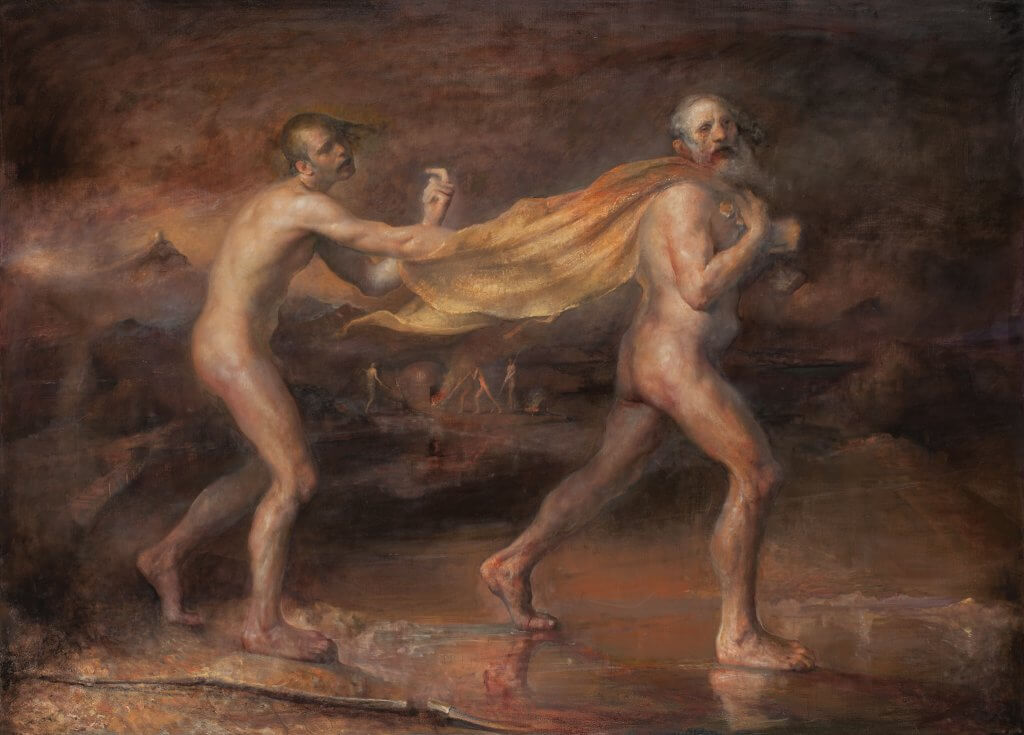
The Golden Cape (2009) by Odd Nerdrum
In the traditional hunt of the talent, Nerdrum becomes just another scapegoat in the company of Amundsen, Flagstad, Hamsun and Munch.
But while the focus increasingly centers around him, his imagery is shoved into the background. Parallel to his exile and the court cases, Nerdrum’s paintings become rougher and more vibrant. The motifs are now staged in a world where the surroundings are ravaging the people. Where bestiality has got the upper hand.
With a reinforced focus on the rawness in nature, the imagery turns away from Rembrandt, towards a Renaissance master who Nerdrum, with time, will consider to be greater that all other painters.
(Odd Nerdrum was pardoned by King Harald V, 22. September 2017)
This is the fourth in a series of six articles based on “The Hunt of Odd Nerdrum” (2018) which is available for streaming at vimeo.com/ondemand/oddnerdrum.
Members of WWK get 25% off any purchase. Send an e-mail to nerdrum.bork@gmail.com for more information.
The Hunt of Odd Nerdrum
Deciding to track down Odd Nerdrum’s sources of inspiration, his former pupil Jan-Ove Tuv and his son Öde go on a world tour, visiting the museums and people that crossed paths with the painter in his pursuit of the immortal masterpiece.
Genre: Documentary Duration: 4 h 26 min
Subtitles: English, Spanish and Chinese
Published on Saturday, June 30th, 2018
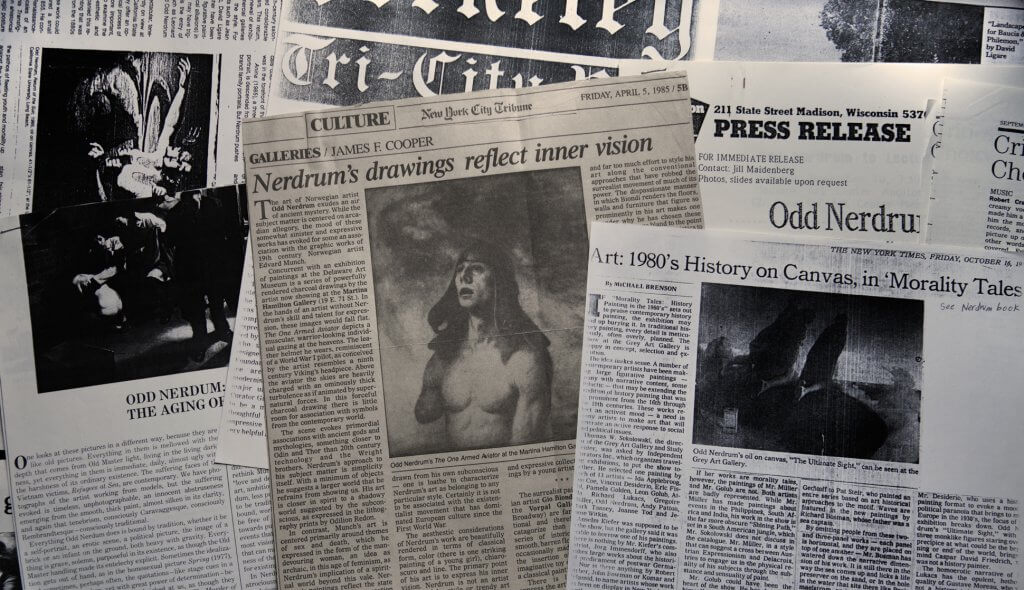


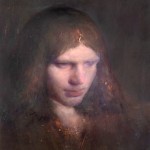
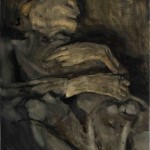
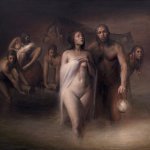
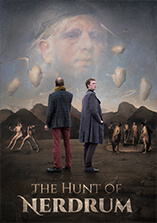
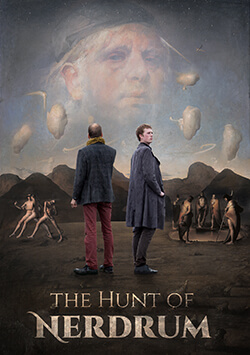
He’s horribly overrated and he’s an egomaniacal prick!